ADAM MAGYAR IS A computer geek, a college dropout, a self-taught photographer, a high-tech Rube Goldberg, a world traveler, and a conceptual artist of growing global acclaim. But nobody had ever suggested that he might also be a terrorist until the morning that he descended into the Union Square subway station in New York.
At the time, Magyar was immersed in a long-running techno-art project calledStainless, creating high-resolution images of speeding subway trains and their passengers, using sophisticated software he created and hardware that he retrofitted himself. The scanning technique he developed—combining thousands of pixel-wide slices into a single image—allows him to catch passengers unawares as they hurtle through dark subway tunnels, fixing them in haunting images filled with detail no ordinary camera can capture.
Magyar set up his standard array of devices—camera, scanner, voltage meters, blue and black cables, battery pack, tripod, laptop—and waited for a train to roll into the station. He hadn’t anticipated the vigilance of post-9/11 New Yorkers, several of whom complained to the police about the longhaired man wielding what looked like a jerry-built piece of surveillance equipment. It didn’t take long before a transit cop approached him.
“What are you doing?” he asked.
“I’m scanning trains,” Magyar said.
The policeman led Magyar to a room in the bowels of Union Square, then summoned a pair of plainclothes officers to interrogate him. They inspected his equipment, pored through his digital files. “Tell us who you’re working for,” they said.
Once Magyar convinced them that he was not scrutinizing the subway for nefarious purposes, that he was an artist (his website, featuring examples of his work, helped), the police settled on a $25 fine for violating a regulation against using a tripod on the platform, and sent him on his way.

IT WAS NOT THE FIRST TIME that Adam Magyar has had to explain his work to mystified observers. Born in Hungary in 1972, Magyar began taking pictures in his late twenties, roaming the streets of Asian cities and capturing images of Indian street vendors, Hindu holy men, and Himalayan students. His work evolved rapidly from conventional documentary photography to surreal, radically experimental imagery that reflects his obsession with finding innovative new uses for digital technology. A self-taught engineer and software designer who assembled his first computer while in his teens, Magyar captures his images using some of the world’s most sophisticated photographic equipment, modified with software he writes himself. Additional code, also of his own design, removes nearly all distortion, or “noise,” from his data, producing images of remarkable clarity.
In a growing body of photographic and video art done over the past decade, Magyar bends conventional representations of time and space, stretching milliseconds into minutes, freezing moments with a resolution that the naked eye could never have perceived. His art evokes such variegated sources as Albert Einstein, Zen Buddhism, even the 1960s TV series The Twilight Zone.The images—sleek silver subway cars, solemn commuters lost in private worlds—are beautiful and elegant, but also produce feelings of disquiet. “These moments I capture are meaningless, there is no story in them, and if you can catch the core, the essence of being, you capture probably everything,” Magyar says in one of the many cryptic comments about his work that reflect both their hypnotic appeal and their elusiveness. There is a sense of stepping into a different dimension, of inhabiting a space between stillness and movement, a time-warp world where the rules of physics don’t apply.
“I grew up in my father’s workshop. I learned to work with tools, I developed a general understanding of materials. And I learned how to combine things.”
Magyar’s work represents a fruitful cross-fertilization of technology and art, two disciplines—one objective and mathematical, the other entirely subjective—that weren’t always regarded as harmonious or compatible. Yet the two are intertwined, and breakthroughs in technology have often made new forms of art possible. Five thousand years ago, Egyptian technicians heated desert sand, limestone, potash, and copper carbonate in kilns to make a synthetic pigment known as “Egyptian blue,” which contributed to the highly realistic yet stylized portraiture of the Second and Third Dynasties.
By the fifteenth century, paint based on transparent walnut and linseed oil began to replace opaque egg-based tempera, infusing art with a new luminosity and naturalism that paved the way for Renaissance masters like Jan Van Eyck, Tintoretto, and Caravaggio. Nineteenth-century experiments with light-sensitive materials capable of capturing and stabilizing an image—beginning with Louis Daguerre’s silver-plated sheets of copper fumed with iodine vapor—led to the invention of photography. In the 1950s, rapid improvements in emulsions and film speed allowed movie directors to take their craft outdoors and shoot in minimal light—propelling the naturalistic New Wave cinema of Jean-Luc Godard and other innovators.
Digital photography, first developed in the 1970s, gave rise to two types of image-capturing devices: standard digital cameras and scanners. The former captures an entire subject in a single exposure. The latter, by contrast, captures an image in a sequence. The sensor moves over the subject—a printed document, for example—and photographs it line by line, then assembles a composite image. Scanners, graphics-editing programs, and high-speed industrial video cameras have allowed conceptual artists to break the bounds of conventional photography and become increasingly abstract and surreal.
Doris Mitsch, based in Northern California, scans flora, sea creatures, and other natural objects into an old G4 Mac, then tweaks them in Photoshop to create stunningly lucid compositions unobtainable by even the highest-speed cameras. Penelope Umbrico assembles images found online into vast collages. Her 541,795 Suns (from Sunsets) from Flickr, created in 2006, reflects her fascination with the Internet and the ways in which it has subsumed other realities. And the Latvia-born photographer Misha Gordin creates nightmarish, black-and-white composite images, such as his acclaimed “Crowd” series, that conjure up the oppression of totalitarian systems. “In conceptual photography . . . the idea or vision is transformed by the camera to an image connected to reality only by my imagination,” Gordin once wrote. “The initial process is similar to writing poetry. From there it becomes more technical.” Magyar, an admirer of Gordin’s work, also creates black-and-white photographs and video images permeated with a similar brooding quality, though his human beings are bound not by political systems, but by the limits of perception.
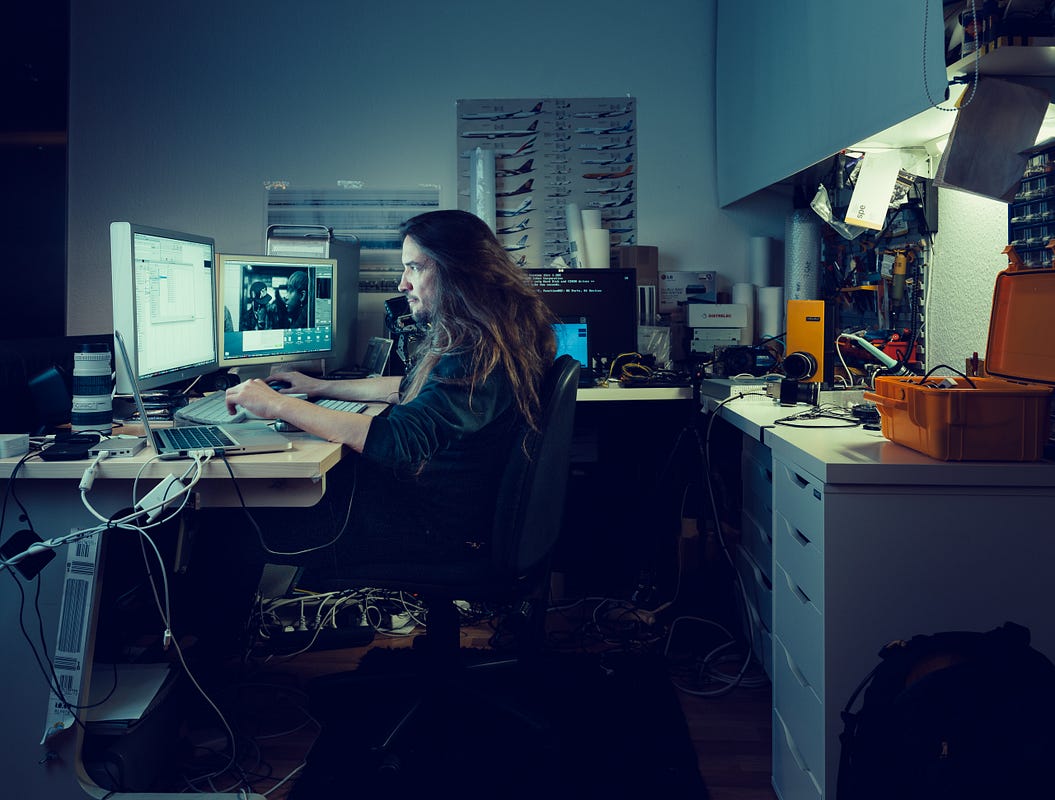
I FIRST MET MAGYAR at his tidy one-bedroom apartment in Friedrichshain, a gentrifying neighborhood in the former East Berlin. He has long, dark hair, a thin beard and mustache, and dark, brooding eyes; he looks like a Renaissance portrait of a Slavic saint, or an aging rocker from one of Berlin’s last surviving squatter apartment buildings.
Magyar has lived in Berlin since January 2008, yet has had few gallery exhibitions there and doesn’t mingle with local artists. “The galleries are a bit punk, and my stuff is an engineer kind of thing,” he told me, brewing espresso in the kitchen, while his girlfriend, Zazi Porcsalmy, a Hungarian translator whom he has known since high school, served Christmas cookies in the living room. Although he has lived in Berlin for six years, Magyar barely speaks German, a reflection of both his immersion in other disciplines—“I spent the time here learning two computer languages, I didn’t have time for anything else,” he explains—and the detached-observer quality that permeates his work. Like the subway passengers he pins down in his Stainless series, I’ve managed to pin down Magyar during a momentary pause in a life of constant motion: He’s permanently passing through.
Magyar was born and raised in the Hungarian city of Debrecen, a regional center of 200,000 just west of the Romanian border. His mother was a dentist, his father an architect and interior designer who created bars and restaurants for a state-owned company during the Communist era. The elder Magyar moonlighted as an artist, making fanciful light fixtures and other household objects out of copper in a workshop beside his home. “I grew up in my father’s workshop,” Magyar remembers. “I learned to work with tools, I developed a general understanding of materials. And I learned how to combine things.” Magyar’s parents sent him to an elementary school that specialized in music, and he sang with Hungary’s most prestigious youth choir, performing in Finland and Greece when most travel to the West was banned. He attended an advanced technological high school, but he found the curriculum too theoretical and rebelled against the discipline. “I was the only one in the class who didn’t have to wear a uniform. I was never easily controllable,” he says. Magyar dropped out of college, taught himself computer code, built rudimentary computers, and supported himself doing graphic design on a freelance basis and, for two years, running a one-man business that printed corporate logos on pencils and cigarette lighters. “It was horrible, but it was money,” he told me.
By this point the Berlin Wall had fallen, the Eastern Bloc had dissolved, and Magyar could indulge a growing wanderlust. “I always wanted to travel, ever since I remembered. I was about four when I was dreaming about leaving for the world,” he recalls. “My father once told me that there used to be people whose profession was ‘traveler,’ and I took it literally. I liked the idea of living from a suitcase, going from place to place. I think it stuck in my brain. When I received my first salary, I just left. I think I am a permanent traveler in a way.” He backpacked through Morocco and, at 27, visited India for the first time. “It was the most difficult place I had ever been,” he says. “The colors, the smells—it’s heavy to digest. It became a kind of icon, and I started going back every year.”
Magyar’s life of travel honed his skills as an observer and reinforced his sense of being an outsider. At one level he seemed in constant motion. At another level he was capable of remaining still for long periods simply watching the flow of life. He once spent six months studying the movement of the river in Varanasi, the ancient Hindu capital on the Ganges. During that trip, he asked Zazi to bring him a book on introductory photography that he had won as a prize years before in elementary school. “I was almost 30,” he said. “And I started learning about apertures and light and developing my stuff in a darkroom. I loved it.” A year later, he documented daily life at a private school in Darjeeling, a Himalayan hill station in northeastern India, and his series of black-and-white photos won first prize in the annual Hungarian Press Photography competition. “He never worked too fast,” Zazi remembers. “If he found a person or a place intriguing he’d stand around for hours.”
But Magyar quickly found that straightforward documentary photography bored him. He set up a camera inside a movie theater in Varanasi, and shot one-minute exposures of the audience in near-total darkness. He shot images of passengers seated in the rear of taxis in Calcutta, and individuals framed inside doctors’ waiting rooms and in an elevator in Shanghai. Hannah Frieser, the former director of Light Work, an artist-run cooperative that organized an ambitious exhibition of Magyar’s work, Kontinuum, in three U.S. museums in 2013—Light Work in Syracuse, the Houston Center for Photography, and the Griffin Museum of Photography outside Boston—says that “the elevator series is pivotal to understanding him. It reflects this idea of taking your camera and making it the stationary part and photographing individuals over and over again. He doesn’t look at people in a judgmental way. He avoids asking a lot of questions. Instead it is just this experience of observing and being present, and defining life through this flow.” The work also reflected Magyar’s growing interest in the limitations of the human sensory perception, compared to what was possible with certain new and old technologies, and prefigured his efforts to push the boundaries of what we can see and experience. “I wanted to surround people in a cage, in a way. I was thinking about how little choice we have when we select our path,” he told me. “We are able to see just a narrow angle, whatever we do. Our knowledge is really limited, and small.”
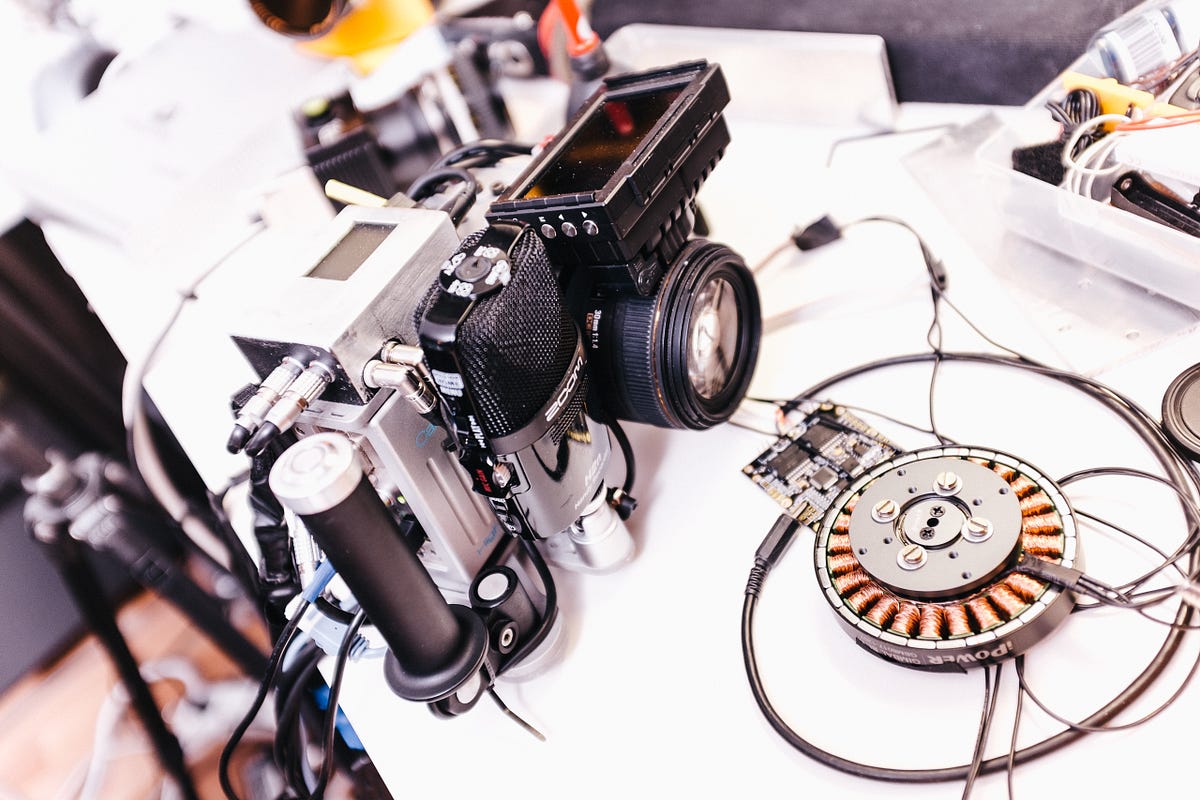
MAGYAR BEGAN EXPERIMENTING with scanning in 2003. “I wanted to get out of conventional photography,” he told me. “I remember I didn’t sleep too much. I was up whole nights, thinking about how to do it.” In an early experiment, Magyar built his own primitive scanner, using an East German slide projector that cast a narrow light beam. Then he constructed a platform out of a stack of Lego bricks that permitted the beam to “scan” across a subject by slowly tilting from top to bottom. A standard reflex camera captured all of the scanned lines in a single shot, re-assembling them into one image during a minute-long exposure. In effect, the scanner was slicing a minute of time into thin sections, and the camera was stacking the slices back together, creating a single image composed of all those moments. Magyar took to scanning himself, experimenting with different physical movements that created distorted final images. “When you turned around, the image that came out showed your body as a corkscrew,” he says. “It was an interesting technological experiment, but that was it. I put it away for years.”
He remained fascinated, however, by the notion of capturing different parts of a person or of people at different times, constructing a still image out of “little pieces,” he says. This matched his growing interest in what he calls “the ever-changing nature of the present,” the constant flow of life that defied easy visual representation.
In 2006, during a months-long stay in Shanghai, he had an epiphany. “I had this feeling that I would, like, scan the flow of people. I began looking for the right kind of spaces where I could find a monotonous flow.” Magyar first studied escalators in Shanghai shopping malls. Then his gaze shifted to city streets—particularly major intersections or bus stops with a continuous procession of humanity. Once he had the concept in his head, he set about to develop the technology to realize it. “It was continuous research,” he says. “It took me a few weeks to figure it out.”
The answer, Magyar realized, was a modified version of the “slit scan” camera, the type used to determine photo finishes at racetracks and at Olympic sporting events by capturing a time sequence in one image. Such cameras were rare and cost many thousands of dollars, so Magyar set out to build one himself. He joined a medium-format camera lens to another sensor and wrote his own software for the new device. Total cost: $50. He inverted the traditional scanning method, where the sensor moves across a stationary object. This time, the sensor would remain still while the scanned objects were in motion, being photographed one consecutive pixel-wide strip at a time. (This is the basic principle of the photo-finish camera.) Magyar mounted the device on a tripod in a busy Shanghai neighborhood and scanned pedestrians as they passed in front of the sensor. He then digitally combined over 100,000 sequential strips into high-resolution photographs.
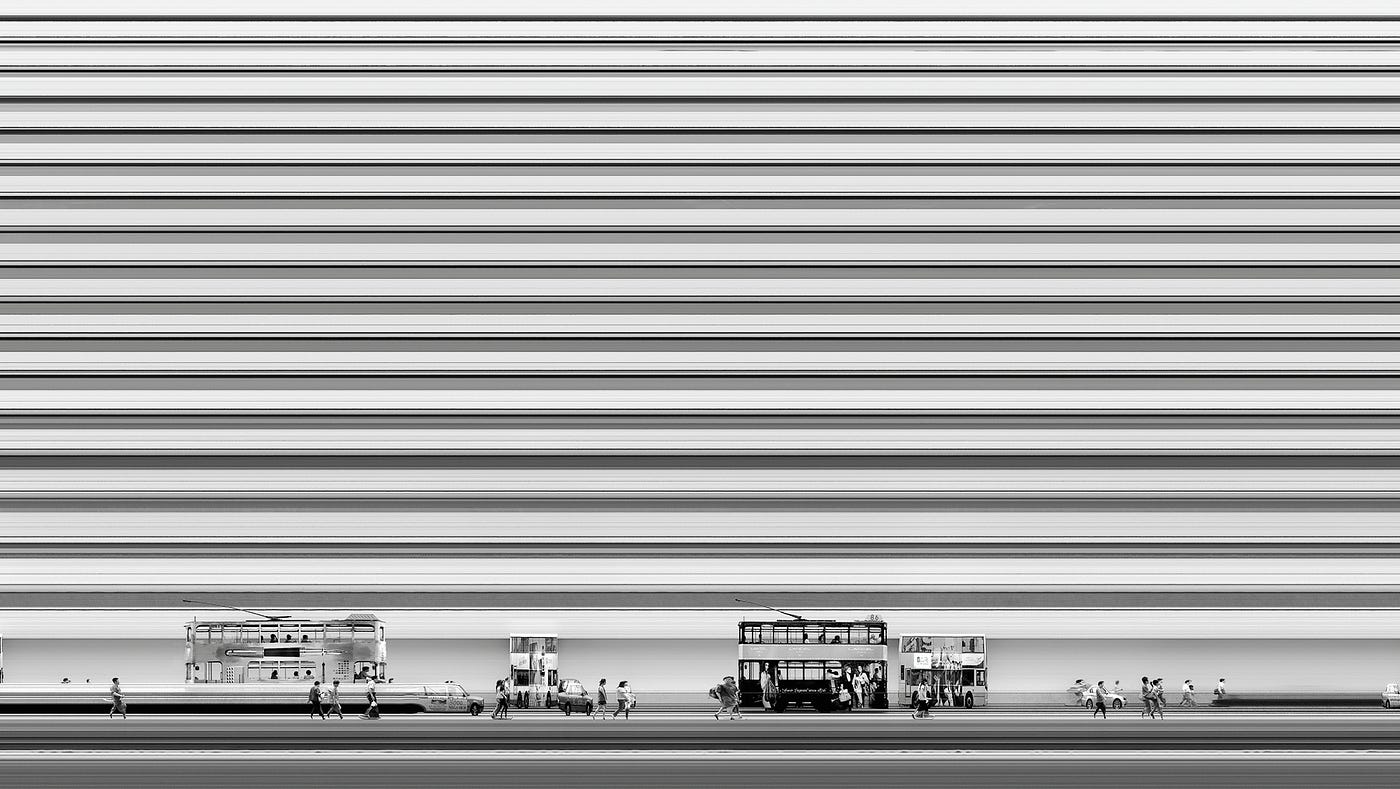
The result was Urban Flow, a series of one-foot-high, eight-foot-long prints that captured a parade of humanity marching through time: Those at the far right had passed by the sensor approximately two minutes before those on the far left. “Each little fragment is the present, and all these present fractions come together to give you the story,” Magyar explains. “By the time we see the story, it’s like our memory. It’s already past.”
Eerie distortions of objects in motion and at rest reminded viewers that they were looking at a pictorial representation of time, not space. Speeding buses were compressed into Smart cars. Passing buses were elongated like Metroliners. Slower walkers had billowing pants legs, or feet like skis, or Oscar Pistorius–style blades. And because of the peculiar nature of the scanning technology, everyone was moving in the same direction. “The horizontal axis is not about space, it’s not about left and right, it’s about earlier and later,” he says. “If two people are crossing the pixel at the same moment, they will look like they are walking together.”
Urban Flow feels both comical and melancholy; like a time-bending, mind-bending vision of human destiny and mortality. The choice of black-and-white imagery came after long consideration. “I experimented with color, but people looked like colorful confetti, which was not my point,” says Magyar. “This is not a carnival, this is a little bit sad for me. We are all heading toward the same destination, which is sort of a death.”
Lars Torkhul, a Shanghai-based design engineer, met Magyar in China, and visited his Shanghai apartment to see the new work in progress. “It was shocking to see the place,” Torkhul recalls. “You had to carve your way past water bottles and other debris into the room to navigate to the desk.” After showing Torkhul his jury-rigged prototype, Magyar displayed the first of theUrban Flow series on the computer screen. “I was blown away by the beauty, the crispness of the image,” says Torkhul. “I said ‘Adam, this is extraordinary, are you going to show it?’ But he hadn’t even thought about it. . . . There was so much technology involved that he hadn’t dealt with before. He said, ‘this is nowhere near ready.’ I replied ‘What do you mean? It can be ready very soon.’”
Torkhul introduced Magyar to a friend, the French artist Thomas Charvériat, who had just opened a gallery, Island6, in a renovated warehouse in the artist’s district of Shanghai. Magyar’s slit-scan photographs captivated Charvériat, too, and he offered to mount an exhibition. Magyar sold nearly every one of the dozen pieces he had on display—at modest prices of between $700 to $1,400—and received orders for several more. Magyar was amazed that his work had any commercial value at all: “I went back to Hungary, but I knew that I had to start building something from this.”
“In Zen you can train for five years before you shoot a bow and arrow. And that describes exactly what Adam does. Time doesn’t exist for him.”
HIS NEXT MAJOR PROJECT was Stainless, shot inside subway stations in major cities like Paris, Tokyo, and New York City. It was a quantum leap forward. He invested in a high-quality industrial camera and a “line scan” device designed to capture high-resolution images of circuit boards, bottle tops, or other fast-moving objects on assembly lines, exposing micro-cracks and other defects incapable of being perceived by standard cameras. The resulting line-scan camera uses a single row of light-sensitive sensors to constantly scan moving objects at high speed, eliminating most distortion.
Stainless consciously calls to mind the realm of theoretical physics, with its references to the thought experiments of Albert Einstein. Magyar’s stationary camera aimed at a moving train bears echoes of Einstein’s hypothesis that “distant simultaneity”—the idea that two spatially separated events occur at the same time—is not absolute, but depends on the observer’s frame of reference. In a famous thought experiment, Einstein imagined two observers—one standing inside a speeding train car, the other on a platform as the train moves past—who perceive the same flash of light at the exact moment that they cross paths. The passenger in the train sees the light strike the front and the back of the train car simultaneously; the stationary bystander sees it hit at different times. Similarly, Magyar warps time and reveals the subjectivity of human perception: His line-scan camera transforms a speeding blur into a frozen image of impossible clarity and stillness, a reality imperceptible to both passengers speeding into the station and bystanders waiting to board the train. The individuals in his trains ride together yet apart, lost in their own thoughts, often transfixed by their hand-held devices.
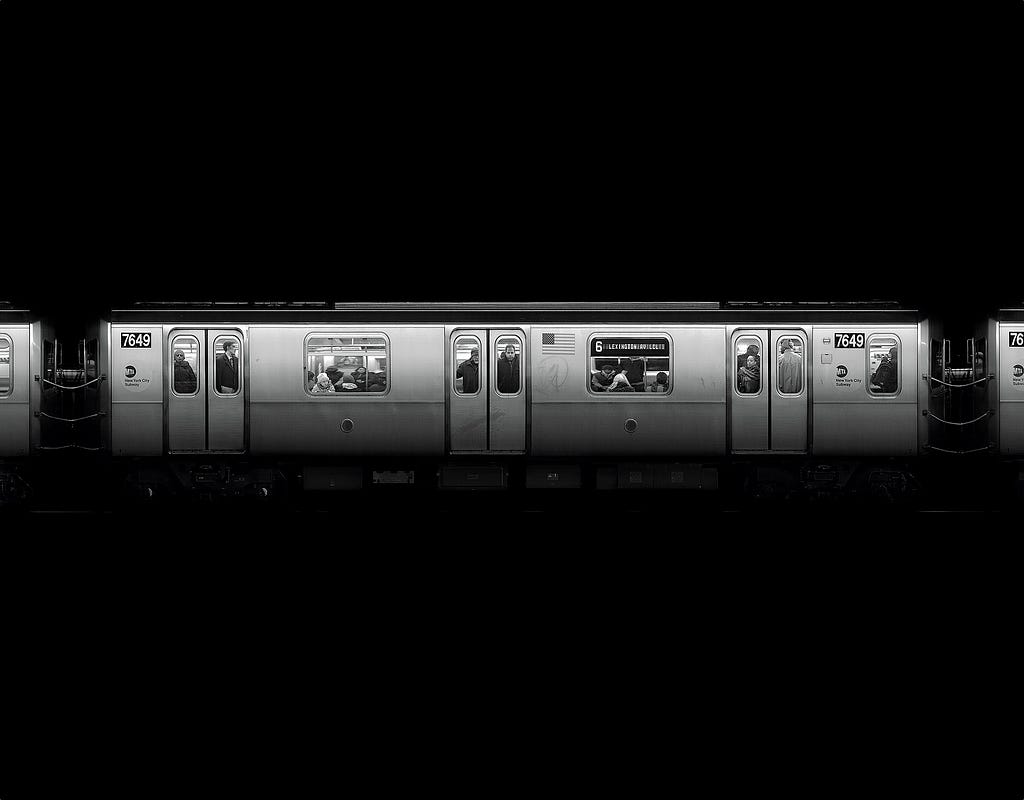
“You start paying attention to how these people interact with their technology, and how they barely interact with each other,” says Hannah Frieser, the former director of Light Work. Yet the eerie images can also be seen as a celebration of the human community, something that Magyar grew increasingly to appreciate as he traveled the world. The straphangers he captured in Paris, Shanghai, Hong Kong, New York, London, Tokyo, Paris, Rome, and Berlin manifest striking similarities in appearance, expression, and attitude that transcend cultural and geographical differences. In her catalog notes for the show, Frieser drew a clear distinction between the street photography practiced by masters such as Diane Arbus, Gary Winograd, and Henri Cartier-Bresson, and Magyar’s kind of image-making. “The life that he chronicles is made up of everyday people, not the most beautiful, eccentric, and destitute who typically draw the attention of photographers,” she wrote. “They looked for differences whereas Magyar ascertains similarities. They kept moving through the city, while Magyar remains stationary and waits for people to move past his camera … He jumps to different cities in various countries and continents until the commonalities within mankind begin to emerge.”
The Stainless photos also offered the most telling example of Magyar’s relentless perfectionism. (Pictured above, Stainless #7649 New York) Magyar desperately wanted to shoot in the tunnels of Tokyo—“the ultimate subway system, the ultimate urban environment” —but a subtle flicker in the lighting produced over-exposed and under-exposed frames that appeared on his images as vertical lines. Magyar’s solution: He rode the subways for a week with his light meter, taking readings at all 290 stations in the network. “I found five stations with high-frequency light, so I could start working there,” he recalls. “But inside the train the light was still bad, so I spent three months making the software to get rid of those lines.” Magyar also faced another problem after his tripod was banned from the New York City subway system. He was obliged to use a hand-held camera, which resulted in further distortions on his images; several weeks were taken up devising more code to eliminate them. Lars Torkuhl, the German design engineer, compares him to a Zen Buddhist master. “In Zen you can train for five years before you shoot a bow and arrow. And that describes exactly what he does,” Torkhul told me. “Time doesn’t exist for him. He lives and executes his work in a crisp, detailed manner, exactly like his pictures.”
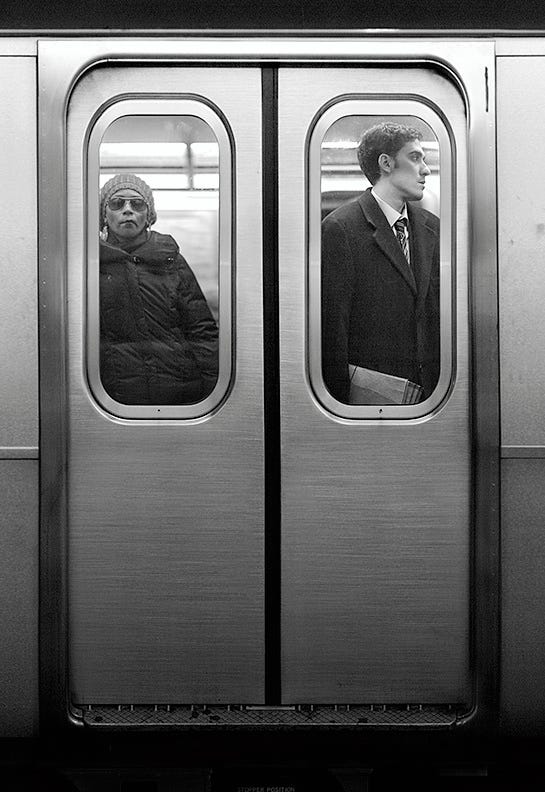
SHORTLY AFTER COMPLETING Stainless, Magyar began to consider transitioning to moving images. After months of research, he persuaded the German manufacturer Optronis to lend him one of its $16,000, high-performance industrial video cameras—used in crash tests and robotic-arm studies, and even for analyzing the hind hooves of show-jumping horses. With a high level of light sensitivity and advanced TimeBench analysis software, the Optronis shoots high-resolution images at astonishing speeds: up to 100,000 frames per second, compared to 24 frames per second in a traditional film camera.
Magyar turned the concept of Stainless on its head: Instead of standing on a platform shooting passengers speeding past him, Magyar now positioned himself inside the moving subway car, recording stationary commuters on the platform as train and camera rolled into the station. Again, the ghost of Einstein permeates these images, and again, he was warping time: Magyar shot the footage at 56 times normal speed, turning 12-second blurs into nearly 12-minute films of excruciating slowness. His commuters stand, together yet apart, with the studied, three-dimensional grace of statues—only the twitch of a lip or a finger drawn toward an iPhone indicating that these people were caught in hyper-slow motion, inhabiting an elongated moment. Magyar extracts drama from an infinitesimal flash of time. “I want to capture something that happens in milliseconds, something that you don’t even realize took place,” he told me. “I’m extending the moments—the present, the now—because as humans we live only in the past and the future. But the only existence we have is now, and that is something that we don’t even consider.”
The breathtaking clarity of the Stainless videos is also the result of the most challenging software code he has ever had to write. In his experiments with industrial cameras, Magyar found that the image quality was ideal for measuring speed, distance, and volume, but not entirely suitable for the demands of an artist. He wrote complex programs to improve the quality of images shot in conditions of low lighting and poor contrast. Another problem was image noise—columns, rows, lines, and other random distortions, a typical issue with high-sensitivity digital sensors. He spent nearly two years, on and off, developing noise-reduction software, solving one problem only to confront a new one. “The engineers don’t have to deal with this, but I do. I cannot sleep. I’m working on this for months, and I don’t stop. You find a new problem, and you have to find a solution.”
A COUPLE OF MORNINGS after our first encounter, I arrange to meet Magyar at Alexanderplatz, one of Berlin’s busiest subway stations, for a demonstration of the Stainless project. I arrive at the height of rush hour, and wait for ten minutes at one end of the crowded platform before he appears. His long hair spills over his black parka, which is matched by black work boots, black jeans, and a black daypack. Inside the pack, Magyar carries his customized Optronis video camera and a laptop. Four cables, blue and black, poke out of the bag. He says the bulky apparatus makes him feel like “the guy from Ghostbusters.” After his run-in with the police at Union Station, Magyar adapted his equipment so that he can conceal it inside a backpack, but to my eye the new setup seems likely to raise even more suspicions.
Six aboveground lines (S Bahn) and three underground lines (U Bahn) converge at Alexanderplatz, creating a constant flow of traffic throughout the morning. “I am looking for a situation where there is no gap, the more people the better,” he tells me. “There are only a couple of spots in every city that can provide that sort of crowd, and this is one of them.”
Magyar and I hop on the U2 and travel one stop to Rosa Luxemburg Platz, then cross the platform and catch the next train heading back to Alexanderplatz. In the crowded car Magyar fishes the apparatus out of his backpack. The gray aluminum camera body, adapted with viewfinder, hand grip, and cables that connect the device to his laptop and battery back, looks like a prototype cobbled together in a backyard garage. Red and green lights blink as he aims the lens through the window “I’m always getting asked, ‘Did you make this yourself?’” he tells me, as commuters gape in curiosity. Minutes later, we rumble into the station, and Magyar begins taping. It is all over in twelve seconds.
We stand and wait four minutes while the eight gigabytes of new data download to his laptop. (During his road trips he typically carries two hard drives that together can store three terabytes.) Magyar studies the procession of beautifully lit faces that he has extracted from the twelve-second blur, and pronounces himself satisfied. He shoots hundreds of hours of video to obtain the results he wants; one of his favorites in the series, shot in 2011 at Alexanderplatz (see video), serendipitously captures, in the background, two little girls loping along the platform. Their graceful movements contrast with the stillness of the commuters in the foreground—a jolting reminder that that the image one is witnessing is not a photo, but a stretched-out moment—what Magyar calls “in-between time.” “Those girls were a real gift to me,” he says.
“His work says that we are alive and that the world is even more of a living place than we are aware of.”

Of all the many disciplines involved in his work, marketing has not come easily to Magyar. He fell into the art world haphazardly, and in the early part of his career he was mystified about how the business worked. “It’s not really nice to live with the naiveté of a 20-year-old when you are 35,” he admitted a couple of days later, as we drove across Berlin on a rainy night to his custom frame shop in the posh neighborhood of Savigny Platz. Magyar was preparing to ship several prints of Urban Flow to an art show in Miami Beach. “I started this in the worst time—2008, 2009—when the art market had collapsed” he says. Five years have passed since then, and Magyar is now fetching considerably higher prices for his work—up to $14,000 per print of Stainless—but he is still uncomfortable with the networking and self-promotion that goes with the territory. “His commercial instincts suck,” says Lars Torkhul.
Still, Magyar has been learning. He has become a more poised and self-confident public speaker, seamlessly weaving together the conceptual and the technological aspects of his work. This year, for the first time, he was able to make a living just from art sales. There have been gallery openings from Harvard University to Budapest. In February, his work will be exhibited as part of three-artist show on urban life at the prestigious Julie Saul Gallery in Manhattan. The exhibition will include a Stainless video and several prints from his playful Squares series, done between 2006 and 2009: high-resolution photographs of hundreds of individuals shot from pedestrian overpasses and bridges, then Photoshopped together to create imaginary public plazas as seen from high above. “I have nothing to complain about,” Magyar says.
Magyar is planning a future gallery installation in which he will project several videos on huge screens that surround the spectators, and accompany the visuals with ominous sound effects—the drawn-out squeaking of brakes, the ambient noise of the subway station. “Sometimes people tell me that when they look at the videos, they think about death. It’s a bit like leaving your body,” he says.
Andrew Zolli is the Executive Director of Pop Tech, an organization that brings together innovators in the arts and sciences. After encountering Magyar’s work, he invited the artist to speak at Pop Tech’s most recent conference in Camden, Maine. He takes a different view of the work. “His work says that we are alive,” Zolli insists, “and that the world is even more of a living place than we are aware of.”
Either way, life or death, Magyar relishes the entire range of reactions: “What could be better for an artist than that? This is an amazing feeling, when you can do something that others think about. And when it happens, I’m really happy.”
//.
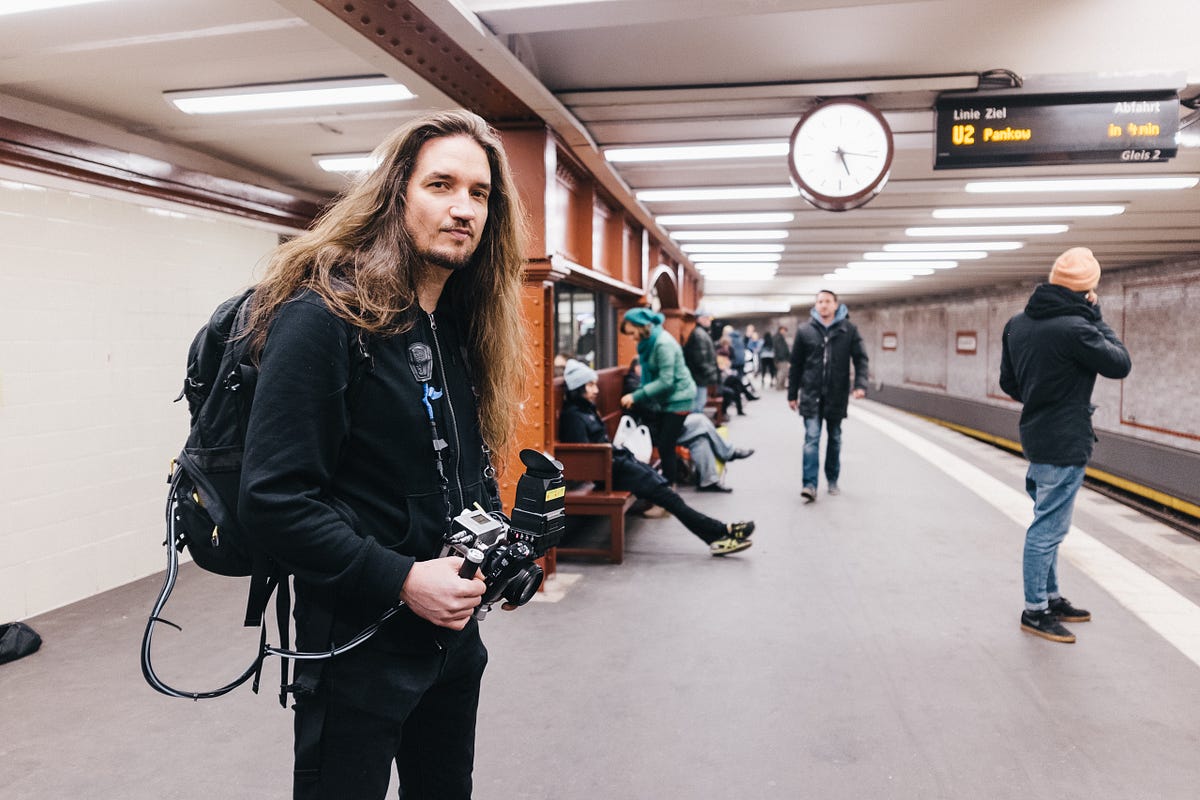
MATTER: The best writing, the biggest ideas.
Want more? Click the green button below to follow us on Medium. And more still? Sign up for our weekly pick of the finest long-form, find us onFacebook or connect via Twitter.
This profile of Adam Magyar was written by Joshua Hammer, edited by Mark Horowitz, fact-checked by Hilary Elkins, and copy-edited by Tim Heffernan. Nicky Barber narrated the audio version. All images were taken by photographerAndreas Chudowski.
No comments:
Post a Comment
Note: Only a member of this blog may post a comment.